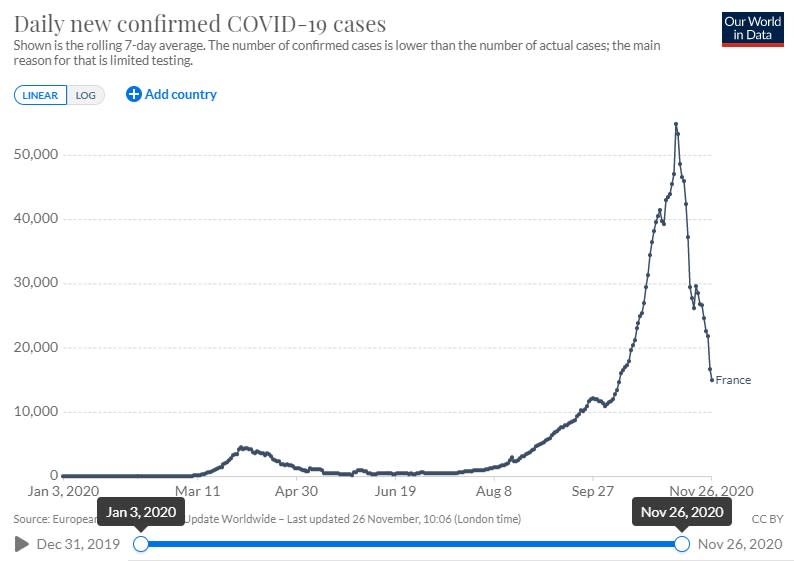The European country that has brought the R Rate below 1
France has managed to get its R rate below 1, despite suffering one of the worst second waves of COVID-19 in Europe.
Prime minister Jean Castex said on Thursday the R rate was now 0.65 countrywide, the same level France reached at the end of a three-month national lockdown in the spring.
Despite the encouraging news, Castex warned that citizens must not lower their guard over the festive holidays.
He said: "Your efforts are paying dividends, pressure from the epidemic is weakening and it is weakening more in France than in other European nations."
The R rate in the UK is currently between 1 and 1.1 after reaching a high of 1.6 in October.
Watch: France R number falls below 1 - but coronavirus patient hospitalised 'every 30 seconds'
Read more: Chris Whitty says don’t hug elderly relatives 'if you want them to survive'
The R rate has been seen as a key indicator during the pandemic – it represents how many people an infected person will pass the disease onto on average.
When the R is above 1 it means the pandemic is growing exponentially, and when it is below 1 it means the epidemic is receding from general circulation.

President Emmanuel Macron this week announced a phased unwinding of France’s lockdown from Saturday, starting with the re-opening of non-essential shops and then theatres, museums and cinemas in mid-December.
France’s second wave
France was the first country in Europe to report more than two million cases of coronavirus after the second wave gripped the nation.
It recorded almost 87,000 new cases in a single day on 7 November, a figure that has now plummeted to around 9,500 per day.
Read more
The Tier 3 COVID lockdown rules explained
The Tier 2 COVID lockdown rules explained
What tier are you in? Full list of lockdown areas
France implemented a harsh second lockdown a week earlier than the UK on 30 October.
People were banned from leaving their homes unless they had a valid reason and faced fines of over 100 Euros for breaking the rules.
Children had to wear masks in class, while universities and many non-essential businesses were closed.
People were only allowed to travel within 1km of their home and could only exercise outside for an hour a day.
France is planning on slowly lifting the lockdown from 28 November in phases, with shops and and places of worship the first to reopen.
The full lockdown will be officially lifted on 15 December but a 9pm curfew will be in place and bars and restaurants will remain closed until 20 January.
Health Minister Olivier Veran recently warned the second wave was not over despite the fall in infections.
He said a COVID-19 patient was admitted to intensive care every six minutes, adding France will not reduce the number of new infections to 5,000 per day until the end of the second week of December.
Veran said he expected the first vaccines to be rolled out in December and January.
A leading government adviser said mass inoculations would be needed for France to return to some sort of normality in the autumn of 2021.
Watch: How England's new three-tier COVID system will work

